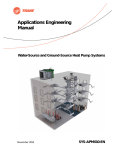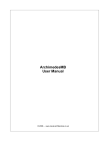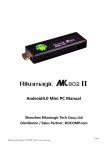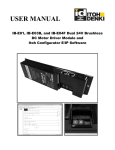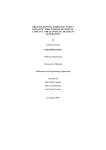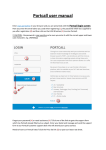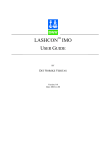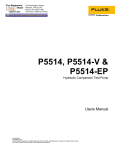Download DNV Ship rules Pt.6 Ch.9 - Loading Computer Systems
Transcript
RULES FOR CLASSIFICATION OF Ships PART 6 CHAPTER 9 NEWBUILDINGS SPECIAL EQUIPMENT AND SYSTEMS – ADDITIONAL CLASS Loading Computer Systems (LCS) for Stability and Longitudinal Strength JANUARY 2012 The electronic pdf version of this document found through http://www.dnv.com is the officially binding version The content of this service document is the subject of intellectual property rights reserved by Det Norske Veritas AS (DNV). The user accepts that it is prohibited by anyone else but DNV and/or its licensees to offer and/or perform classification, certification and/or verification services, including the issuance of certificates and/or declarations of conformity, wholly or partly, on the basis of and/or pursuant to this document whether free of charge or chargeable, without DNV's prior written consent. DNV is not responsible for the consequences arising from any use of this document by others. DET NORSKE VERITAS AS FOREWORD DET NORSKE VERITAS (DNV) is an autonomous and independent foundation with the objectives of safeguarding life, property and the environment, at sea and onshore. DNV undertakes classification, certification, and other verification and consultancy services relating to quality of ships, offshore units and installations, and onshore industries worldwide, and carries out research in relation to these functions. The Rules lay down technical and procedural requirements related to obtaining and retaining a Class Certificate. It is used as a contractual document and includes both requirements and acceptance criteria. © Det Norske Veritas AS January 2012 Any comments may be sent by e-mail to [email protected] For subscription orders or information about subscription terms, please use [email protected] Computer Typesetting (Adobe Frame Maker) by Det Norske Veritas If any person suffers loss or damage which is proved to have been caused by any negligent act or omission of Det Norske Veritas, then Det Norske Veritas shall pay compensation to such person for his proved direct loss or damage. However, the compensation shall not exceed an amount equal to ten times the fee charged for the service in question, provided that the maximum compensation shall never exceed USD 2 million. In this provision "Det Norske Veritas" shall mean the Foundation Det Norske Veritas as well as all its subsidiaries, directors, officers, employees, agents and any other acting on behalf of Det Norske Veritas. Rules for Ships, January 2012 Pt.6 Ch.9 Changes – Page 3 CHANGES General The present edition of the rules includes additions and amendments approved by the Executive Committee as of November 2011, and supersedes the January 2011 edition of the same chapter. The rule changes come into force as indicated below. Text affected by the main rule changes in this edition is highlighted in red colour. However, where the changes involve a whole chapter, section or sub-section, only the title may be in red colour. This chapter is valid until superseded by a revised chapter. Main changes coming into force 1 July 2012 • Section 1 General Requirements — A104: The required stability tasks are further specified — A303: Requirement added for the software to give a warning when damage calculations are not updated (in case of direct calculations) — A304: Additional draught check required for certain vessels. • Section 2 Approval — A204: Operation/User manual only to be submitted if tailor made for a ship (type approved software) (see table A1) — A208: Some adjustment made in the requirement for content of operation/user’s manual — A210: Listing of damage results (direct damage calculations) to be shown in summary table — A303: Longitudinal strength: Tolerances for check of results in vessel’s ends adjusted — A400: Handling of updates/new version of software, and update of vessel data further explained/clarified. • Section 3 Certification — A210: Issues related to testing on board on preliminary or final version of the software clarified. • Section 4 Additional class notation LCS-DC — A201/B204: Option added for checking longitudinal strength after damage for ships with the optional LCS-DC notation — B100: Requirement for documentation of hardware related to the LCS-DC notation is altered some — B103: The requirement for documentation of calculation of damage cases further specified. Corrections and Clarifications In addition to the above stated rule requirements, a number of corrections and clarifications have been made in the existing rule text. DET NORSKE VERITAS AS Rules for Ships, January 2012 Pt.6 Ch.9 Contents – Page 4 CONTENTS Sec. 1 A. A A A A Classification.................................................................................................................................................................. 5 100 Application............................................................................................................................................................ 5 200 General requirements ............................................................................................................................................ 5 300 General software requirements ............................................................................................................................. 6 400 General hardware requirements ............................................................................................................................ 8 Sec. 2 A. A A A A General Requirements ....................................................................................................................... 5 Approval.............................................................................................................................................. 9 Documentation to Submit for Approval .................................................................................................................... 9 100 Documentation of hardware.................................................................................................................................. 9 200 Software documentation ....................................................................................................................................... 9 300 Acceptable tolerances, stability software ........................................................................................................... 12 400 Note for ships in operation, documentation for software approval .................................................................... 13 Sec. 3 Certification ...................................................................................................................................... 15 A. Certification ................................................................................................................................................................. 15 A 100 Principles for certification................................................................................................................................... 15 A 200 Procedure for certification .................................................................................................................................. 15 Sec. 4 Additional Class Notation LCS-DC................................................................................................ 16 A. Application................................................................................................................................................................... 16 A 100 Application.......................................................................................................................................................... 16 A 200 System description .............................................................................................................................................. 16 B. B B B General Requirements ................................................................................................................................................ 16 100 Documentation.................................................................................................................................................... 16 200 System requirements........................................................................................................................................... 17 300 Location of sensors in internal compartments and spaces .................................................................................. 17 C. Testing .......................................................................................................................................................................... 18 C 100 Installation testing............................................................................................................................................... 18 C 200 Testing during operation ..................................................................................................................................... 18 DET NORSKE VERITAS AS Rules for Ships, January 2012 Pt.6 Ch.9 Sec.1 – Page 5 SECTION 1 GENERAL REQUIREMENTS A. Classification A 100 Application 101 A loading computer system is a computer based system for calculation and control of loading conditions for compliance with the applicable stability requirements and longitudinal and local strength requirements. The loading computer system consists of software (calculation program) and the computer (hardware) on which it runs. Guidance note: The DNV expression “loading computer system” covers the IACS expression “Loading instrument”, and the IACS definition thereof: “A loading instrument is an instrument, which unless stated otherwise is digital, by means of which it can be easily and quickly ascertained that, at specified read-out points, the still water bending moments, shear forces, and the still water torsion moments and lateral loads, where applicable, in any load or ballast condition will not exceed the specified permissible values.” ---e-n-d---of---G-u-i-d-a-n-c-e---n-o-t-e--- 102 The requirements of this chapter apply to ships equipped with a loading computer system. 103 Ships for which a loading computer system calculating hull strength is required, is defined in Pt.3 Ch.1 Sec.5, subsections A and F, and in Pt.3 Ch.2 Sec.4 E. Irrespective of the above requirements, if a loading computer calculating hull strength is installed onboard, all applicable limitations is to be included and verified by the Society. 104 Except as given in 105, the stability software installed onboard shall cover all applicable stability criteria required by mandatory class notations and relevant IMO Conventions that are approved by the administration or by the Society on behalf of the administration. Stability criteria required by optional class notations are subject to approval if included. 105 For installations onboard ships contracted prior to 2005-07-01 the following apply: If the loading computer system does not check all the stability requirements as applicable for the ship and cargo type, the users are to be informed accordingly. The requirements not checked are to be displayed on the screen for the actual loading condition, and to be included when printouts are made. (IACS UR L5) A 200 General requirements 201 The loading computer system is regarded as supplementary to the Loading Manual and the Stability Booklet and if relevant the Grain Loading Manual which are always to be provided on board. 202 Approval and certification of the loading computer system shall be carried out for each specific ship for which the loading computer system is installed. The results of the calculations are only applicable to the ship for which the loading computer system has been approved and certified. 203 The approval and certification process include the following procedures for each ship: a) Approval of software which results in approved Test Conditions. b) Approval of computer hardware, where necessary (see 206). c) Certification of the installed loading computer system which results in loading computer certificate. 204 The approved test conditions shall be kept onboard together with the User's manual and the loading computer certificate. 205 For ships with loading computer system approved for strength, all design conditions upon which the approval of hull scantlings is based, shall be within the system limits. For vessels with class notation CONTAINER or Container Carrier having large deck openings (see Pt.3 Ch.1 Sec.5 A200), the system is generally to include procedures for the control of the torsional response of the still water torsional moment distribution over the length. Guidance note: Guidance for calculation of still water torque at read out points: a) The ship structure may generally be assumed symmetric about the centre line. b) The possible angle of heel may be determined by summing the moments of cargo, ballast and fuel. DET NORSKE VERITAS AS Rules for Ships, January 2012 Pt.6 Ch.9 Sec.1 – Page 6 c) The still water torque may be determined by summing the moments of cargo, ballast and fuel and uprighting moment by the angle of heel successively to each checkpoint. The effects of the angle of heel should be fully accounted for in the summation. ---e-n-d---of---G-u-i-d-a-n-c-e---n-o-t-e--- 206 The approved software is either to be installed on a type approved hardware, or it shall be installed on two nominated computers. If two nominated computers are available, approval of the hardware may be waived, but both nominated computers are subject to certification. In addition, computers which shall be a part of a ship's network should be approved in accordance with other relevant requirements posed by the Society. 207 On-line loading computers shall, if connected to the ship's network, comply with the requirements of Pt.4 Ch.9 Sec.4 for computer based systems. 208 The loading computer system shall be capable of producing print-outs of the results in both numerical and graphical form. The numeric values for strength shall be in both absolute values and as the percentage of the allowable values. These print-outs shall include a description of the corresponding loading condition. 209 All screen and hardcopy output data shall be presented in a clear and unambiguous manner with an identification of the calculation program and the version number. The date and time of the of a saved calculation shall be part of the screen display and hardcopy printout. 210 If the software includes on-line interface, for instance remote tank sounding or draught reading, it is assumed that the remote system is maintained and calibrated as recommended by the manufacturers. 211 Single point loading computer systems (i.e. computers that only check strength at a few designated frame locations) are not acceptable. A 300 General software requirements 301 It is recommended that the design and production of the calculation program are in accordance with appropriate international quality standards, for example ISO 9000-3 or equivalent. 302 The software shall present relevant parameters of each loading condition. The following shall be presented: 1) Deadweight definition 2) Light ship data 3) Displacement and centre of gravity 4) Draughts at the forward and aft perpendiculars and at midship 5) Draughts at the ship's draught marks forward, midship and aft 6) Where applicable, provision should be made available for the introduction of a longitudinal deflection 7) Trim 8) Metacentric height KMt 9) Free surface moments from slack tanks, listed for each tank and in total for the vessel 10) Free surface correction on the initial metacentric height (GM) 11) Free surface correction on the righting lever (GZ) 12) Where applicable, effect of external heeling moments 13) Flooding angle 14) Stability limitations: Listing of all relevant stability criteria: description of the criteria, the limit values, the obtained values and the conclusions (criteria fulfilled or not fulfilled) 15) Strength limitations: Listing of obtained values compared with the limit values: i) Shear forces and bending moments for sea going and harbour conditions ii) Where applicable, shear force correction and corrected shear forces, including detailed information, for sea-going and harbour conditions iii) As applicable for bulk carriers, see Pt.5 Ch.2 Sec.5 1) The mass of cargo and double bottom contents in way of each hold as a function of the draught at mid-hold position 2) The mass of cargo and double bottom contents of any two adjacent holds as a function of the mean draught in way of these holds 3) Above i) and ii) for the hold flooded conditions, seagoing only 4) For bulk carriers which have been designed with two design bending moments, i.e. one reduced DET NORSKE VERITAS AS Rules for Ships, January 2012 Pt.6 Ch.9 Sec.1 – Page 7 bending moment for alternate loading and one full moment for homogeneous loading, the software shall calculate maximum allowable and minimum required mass for each hold for intermediate still water bending moments. iv) Where applicable, still water torsion moments. The calculated forces and moments shall be displayed in both graphical and tabular format, including the percentage of permissible values. The screen and hardcopy output shall display the calculated forces or moments, and the corresponding permissible limit, at each specified read-out point. Alternative limits, e.g. vertical still water bending and torsion may be considered in accordance with the Society's Rules. 16) A clear warning shall be given if any of the strength-, stability- or general- loading limitations (see 304) are not complied with 17) Overall judgement whether all the strength-, stability- and general loading limitations are within the limiting values 18) The data shall be presented as screen and hard copy output to the user in a clear and unambiguous manner. 303 If the software calculates damage stability, this shall be done either with control against approved limit curves (KG, GM) or with direct calculation and control against a predefined group of all the relevant damage cases. If the latter alternative is used, the following shall be fulfilled: 1) The relevant rule damage cases shall be pre-stored in a damage group in the computer 2) Any intended loading condition must be checked against these damage cases 3) The results of the calculation and control shall include the equilibrium position and the GZ curve after damage, as well as control against the criteria 4) The software shall give an overall judgement whether all damage cases comply with the applicable requirements, within an acceptable time. 5) If damage stability calculations have not yet been performed for a new condition, or the loading condition is updated after damage stability calculations have been performed, the software shall give a clear warning that the damage calculations are not up to date, and need to be re-calculated. Unprotected and weathertight openings shall be included and taken into account. Alternatively, zones or lines defining unprotected, weathertight and/or watertight area(s) can be accepted if it is ensured that the effect of all openings is covered. Guidance note: Relevant damage cases are found in the ship's damage stability documentation. To cover unsymmetrical tanks arrangements and/or loading the damage cases should be defined on both port and starboard side of the vessel. In certain cases (e.g. typically for chemical tankers) it may be required to add more damage cases in the loading computer, to cover “lesser extent” variations not included in the stability documentation. The need for this will be considered for each separate case. ---e-n-d---of---G-u-i-d-a-n-c-e---n-o-t-e--- 304 The software shall include general loading limitations as applicable: 1) Maximum draught midship: not to exceed the loadline mark 2) Minimum draught midship: relevant for tankers and bulk carriers designed according to the IACS Common structural rules, and for some LNG carriers 3) Minimum draught forward: due to strength considerations (slamming) 4) Draughts aft, midship and forward to be within the designated reinforced ice belt: relevant for vessels with ICE class, when operating in ice infested waters 5) Minimum metacentric height (GM)/ Maximum vertical centre of gravity (VCG): to satisfy requirements for stability 6) Maximum metacentric height (GM): to limit sloshing in tanks 7) Maximum trim. The loading computer should be capable of accurate and reliable calculations for actual operating range of trim Guidance note: In cases where limit curves, hydrostatics and/or cross curves are given/ approved for specific/limited trim a warning shall be given if the specific/limited trim is exceeded. If the software is based on interpolation for even keel data only, the limiting trim will be considered as maximum (+/-) 1% of the ship's length (Lbp), unless other stricter limits exists (e.g. from damage calculation). ---e-n-d---of---G-u-i-d-a-n-c-e---n-o-t-e--- DET NORSKE VERITAS AS Rules for Ships, January 2012 Pt.6 Ch.9 Sec.1 – Page 8 8) Lateral load limitation: due to strength considerations 9) Cargo tank filling degree as a function of cargo density: due to strength and/or stability considerations 10) Limits to distributed loads on deck: to be limited by the strength for which the deck is approved. 305 The software shall reject input errors by the user. For instance tank volume input shall not exceed maximum tank volume, or negative volume input shall not be accepted. 306 The software and the stored characteristic data shall be protected against erroneous use. The software should be written to ensure that the user can not alter the following fixed data: 1) 2) 3) 4) 5) 6) 7) Light ship data: weight, centre of gravity and weight distribution: Strength limitations Stability criteria Geometric hull form data Hydrostatic data Stability cross curves Compartment definitions including frame spacing, and centres of volume, together with capacity tables (sounding/ullage tables), if appropriate 8) As applicable, flooding angle and/or unprotected and weathertight openings and/or zones or lines covering effect for all openings 9) Where applicable, group of damage cases 10) Where applicable, limit curves (KG, GM). 307 If the software includes on-line interface, for instance remote tank sounding or draught reading, a warning shall be given in case of on-line interface failure. Further, it shall be possible to give the on-line input manually. 308 The software shall be user-friendly, preferably with graphic presentation of loading conditions. 309 Any changes made to the software, which may affect the longitudinal strength or stability aspects, shall be made by the manufacturer or his appointed representative. The Society shall be informed immediately of any changes. Failure to advise of any modifications to the software will invalidate the certificate issued. In such cases, the modified software shall be re-assessed in accordance with the approval and certification procedure. 310 The loading computer system's software may be type approved. The validity and limitations of type approval shall be carefully noted. Type approval of loading computer software is described in Classification Note No. 21.1. Guidance note: Approval for each specific ship is required also for type approved software. ---e-n-d---of---G-u-i-d-a-n-c-e---n-o-t-e--- 311 The software shall monitor operation and activate an alarm when the program is incorrectly of abnormally used. 312 The software and any data stored in the system shall be protected from corruption by loss of power. A 400 General hardware requirements 401 In case two nominated computers are used, these are both to be equipped with separate screen and printing device. DET NORSKE VERITAS AS Rules for Ships, January 2012 Pt.6 Ch.9 Sec.2 – Page 9 SECTION 2 APPROVAL A. Documentation to Submit for Approval A 100 Documentation of hardware 101 Requirements in Pt.4 Ch.9 shall be complied with. 102 If the hardware shall be type approved, documentation for the computer shall be submitted for approval. For requirements to documentation types, see Pt.4 Ch.9. Guidance note: Stand-alone computer hardware a) The Society may issue a Certificate of Type Approval for the shipboard hardware, used by the program, when the hardware has been deemed to satisfy the recommendations specified in b). The Society may stipulate additional requirements. b) The manufacturer should submit details of the hardware to be installed onboard. The following information should be submitted for review and if found satisfactory, the manufacturer will be advised accordingly: 1) The hardware specification 2) Relevant design drawings with materials specified, catalogues, data sheets, calculations and functional descriptions 3) Proposed test programme to demonstrate that the performance provisions of the specified standards may be fulfilled 4) Certificates and reports for relevant tests previously obtained for the product. c) When considering the information described in b) the Society may recognise valid certificates or reports issued by another certification body or accredited laboratory. d) Performance and environmental testing should be carried out in the presence of a surveyor from the Society according to the type testing conditions for type approval detailed in IACS Unified Requirements (UR) E10 “Testing Procedure for Electrical, Control and Instrumentation Equipment, Computers and Peripherals covered by Classification”. The following tests should be successfully completed: 1) 2) 3) 4) 5) 6) 7) 8) 9) 10) Visual inspection Performance test Electric power supply variations Dry heat Damp heat Vibration Inclination. Insulation resistance Cold temperatures Electromagnetic compatibility tests. e) The Society shall be advised of any alterations in the hardware specifications. ---e-n-d---of---G-u-i-d-a-n-c-e---n-o-t-e--- A 200 Software documentation 201 Approval of the software means that the Society approves the software for installation onboard a specific vessel. The approval is based on a review and acceptance of design, calculations method, verification of stored data and test conditions for the specific vessel. The approval is a confirmation that the software is able to give correct results provided that the user's input is correct. 202 All program data shall be in accordance with the onboard strength and stability documentation. 203 The units and reference system of the test conditions and the stored characteristic data shall be the same as used in the onboard strength and stability documentation. 204 For each vessel, documentation shall be submitted as required by Table A1. DET NORSKE VERITAS AS Rules for Ships, January 2012 Pt.6 Ch.9 Sec.2 – Page 10 Table A1 Documentation requirements Object Documentation type I270 – Test conditions I280 – Reference data I270 – Test conditions Loading computer application software Z060 – Functional description Z160 – Operation manual Additional description Preliminary, see 210 See 211 Final, see 212 Not required for type approved software, See 209 Not required if generic for type approved software, See 208 Info AP FI AP FI, TA FI, TA 205 For general requirements to documentation, including definition of the Info codes, see Pt.0 Ch.3 Sec.1. 206 For a full definition of the documentation types, see Pt.0 Ch.3 Sec.2. 207 The approval request form is as given in Classification Note No. 21.1, and shall be submitted for each project: 1) For type approved software, use the form “Approval Request Form for Type Approved Loading Computer Software”. 2) For not type approved software, use the form “Approval Request Form for Loading Computer Software”. 208 The operation manual (or user's manual) shall be written in a concise and unambiguous manner. The use of illustrations and flow charts is recommended. The operation manual shall contain: 1) 2) 3) 4) 5) A general description of the program denoting identification of the program and its version number stated Where applicable, a copy of the type approval certificate Hardware specification needed to run the loading program Listing of error messages and warnings with instructions for actions to be taken by the user in each case Name and drawing number of documentation used as reference for the calculation model: loading manual, trim and stability booklet, damage stability manual, line drawings internal arrangement, as applicable 6) If appropriate, calculation method to derive the forward and after draughts at the actual position of the ships draught marks 7) Listing of stability criteria used 8) Listing of general loading limitations 9) Example of a calculation procedure supported by illustrations and sample computer output 10) Example of computer output of each screen display with explanatory text. 209 The functional (or program) description shall contain the following: 1) Description of functionality, calculation methods and principles, including flow chart(s) 2) Method of application of shear force correction factors. 210 The preliminary test conditions (with the estimated light ship data implemented) shall be as follows: Four standard representative test loading conditions chosen from the loading manual or stability booklet: 1) 2) 3) 4) Light ship condition. Ballast or partly loaded condition. Fully loaded condition. Extreme condition (anticipated worst condition for strength as found in the loading manual). — If the vessel is allowed to trade with some hold(s) empty on full draught, the test loading conditions 3 and 4 shall contain an alternate loading condition. — For bulk carriers as defined in Pt.5 Ch.2 Sec.5 the test loading conditions 3 and 4 shall contain one homogenous and one alternate loading condition, both with intact loading and corresponding hull girder loading in flooded condition. — When severe wind and rolling criteria are evaluated, the parameters and the calculations shall be shown in details for the most critical condition. The results shall be shown for all the conditions. — When damage stability is evaluated, the results of the evaluation shall be shown for all the relevant test conditions. Damage stability is either to be checked by using an approved limit curve (KG, GM) or by direct damage stability control against residual GZ curve. If the latter is included, the results shall be displayed in a summary table covering all damage cases, showing; DET NORSKE VERITAS AS Rules for Ships, January 2012 Pt.6 Ch.9 Sec.2 – Page 11 — — — — — the results on floating position (draught, trim and heel) opening information (smallest reserve to immersion and name of most critical opening) criteria results (obtained result for each relevant criterion) criteria evaluation (OK, Not Met) GZ values (for a selected number of heel angles). — Within the range of these test conditions each compartment shall be loaded at least once. The conditions shall cover the range of draughts from the deepest envisaged loaded condition to the light ballast condition. Where applicable: 5) For bulk carriers which have been designed with a reduced still water bending moment for some specified non-homogeneous conditions as reflected in BC-A and or BC-B* notations. See also Pt.5 Ch.2 Sec.5 A100: Test condition demonstrating the program ability to calculate intermediate maximum allowable and minimum required masses in each hold for intermediate stillwater bending moments. See Pt.5 Ch.2 Sec.5. Note that this condition is normally not found in the loading manual. Where applicable (chosen from loading manual / stability booklet / grain loading booklet): 6) Grain loading test condition including both completely filled and partly filled holds. 7) Grain loading test condition for untrimmed ends. 8) Container loading condition, timber loading condition, towing condition, crane lifting condition or others. 9) Allowable hold loading both for single and two adjacent holds. For not type approved software the warnings shall be demonstrated. The following test conditions shall be submitted: 10) Test condition where limit(s) for strength is (are) marginally exceeded. 11) Test condition where limit(s) for stability is (are) marginally exceeded. 12) Test condition where general loading limitation(s) is (are) marginally exceeded. 211 Reference data (or stored characteristic data) (print out of data base) 1) 2) 3) 4) 5) 6) Main dimensions and, if applicable, the ship's profile. The position of the forward and aft perpendiculars. The position of the forward and aft draught marks. Ship's lightweight and lightweight distribution along the ship's length. Bonjean data at a sufficient number of stations in the length between perpendiculars. Associated limits to still water shear force, bending moments and torque, as applicable for seagoing, harbour and flooded conditions. 7) Number, position and limits of read-out points. The shear force limits shall be specially considered for ships sides and longitudinal bulkheads (See Pt.3 Ch.1 Sec.5 D100). The loading computer shall take into account the local correction of the shear forces for conditions with greater pressure differences on the ship's bottom structure (see Pt.3 Ch.1 Sec.5 D200 to D500). 8) Where applicable, local permissible limits for single and two adjacent hold loading, i. e. maximum allowable and minimum required mass as a function of the appropriate draught and the maximum weight for each hold. 9) Hydrostatic data. 10) Cross curves of stability; (KN data) 11) Tank data; frame spacing, maximum volume, maximum VCG, TCG, LCG and maximum free surface moments (FSM). 12) List of unprotected openings / margin line / flooding angle. Where applicable (if installed in the program): 13) Tank data as function of sounding/filling; volume, VCG, TCG, LCG and FSM. 14) List of limit values (KG, GM). 15) List of weathertight openings /margin line. 16) Lists of grain data; tables of volumetric heeling moment for partly filled holds, tables pertaining to cargo holds filled with ends trimmed and untrimmed, tables of maximum permissible grain heeling moment. 17) Group of damage cases. 18) Other data as; container stowage data, car stowage data, timber loading data (cross curves), data for calculation of severe wind and rolling criteria. 19) General loading limitations. DET NORSKE VERITAS AS Rules for Ships, January 2012 Pt.6 Ch.9 Sec.2 – Page 12 Guidance note: Table A2 Data for strength limitations to be provided to/or accepted by the Society Calculation Data to be provided to/or accepted by the Society Still Water Shear Force a) The read-out points (frame locations) for the SWSF calculations. These points (SWSF) are normally selected at the position of the transverse bulkhead or other obvious boundaries. Additional read-out points may be specified between the bulkheads of long holds or tanks or between container stacks. b) Shear force correction factors and method of application. c) The permissible seagoing and harbour SWSF limits at the read-out points specified in a). Where appropriate, additional sets of permissible SWSF values may be specified. Still Water Bending Moment a) The read-out points (frame locations) for the SWBM calculations. These points (SWBM) are normally selected at the position of the transverse bulkhead, mid-hold or other obvious boundaries. b) The permissible seagoing and harbour SWBM limits at the read-out points specified in a). Where appropriate, additional sets of permissible SWBM values may be specified. Still Water Torsion Moment a) The read-out points (frame locations) for the SWTM calculations. (SWTM), where applicable b) The permissible limits at the read-out points specified in a). ---e-n-d---of---G-u-i-d-a-n-c-e---n-o-t-e--- 212 Final test conditions (with final light ship data implemented) shall contain the test conditions as listed in 210. The test conditions shall have the final light ship data implemented and they shall be taken from the approved onboard loading and stability information. A 300 Acceptable tolerances, stability software 301 Depending on the type and scope of programs, the acceptable tolerances shall be determined differently, according to 302 or 303. Deviation from these tolerances shall not be accepted unless the Society considers that there is a satisfactory explanation for the difference and that there will be no adverse effect on the safety of the ship. Guidance note: Examples of pre-programmed input data include the following: Hydrostatic data: Displacement, LCB, LCF, VCB, KMt and MCT versus draught. Stability data: KN or MS values at appropriate heel/ trim angles versus displacement, stability limits. Compartment data: Volume, LCG, VCG, TCG and FSM/Grain heeling moments versus level of the compartment’s contents. Examples of output data include the following: Hydrostatic data: Displacement, LCB, LCF, VCB, KMt and MCT versus draught as well as actual draughts, trim. Stability data: FSC (free surface correction), GZ-values, KG, GM, KG/GM limits, allowable grain heeling moments, derived stability criteria, e.g. areas under the GZ curve, weather criteria. Compartment data: Calculated volume, LCG, VCG, TCG and FSM/ Grain heeling moments versus level of the compartment’s contents. ---e-n-d---of---G-u-i-d-a-n-c-e---n-o-t-e--- 302 Programs which use only pre-programmed data from the approved stability information as the basis for stability calculations, shall have zero tolerances for the printouts of input data. Output data tolerances shall be close to zero, however, small differences associated with calculation rounding or abridged input data are acceptable. Additionally differences associated with the use of hydrostatic and stability data for trims that differ from those in the approved stability information, may be accepted subject to closer review. 303 Programs which use hull form models as their basis for stability calculations, shall have tolerances for the printouts of basic calculated data established against either data from the approved stability information or data obtained using the approval authority’s model. Acceptable tolerances shall be in accordance with Table A3. DET NORSKE VERITAS AS Rules for Ships, January 2012 Pt.6 Ch.9 Sec.2 – Page 13 Table A3 Acceptable tolerances Hull form dependent parameters Displacement Longitudinal centre of buoyancy Vertical centre of buoyancy Transverse centre of buoyancy Longitudinal centre of flotation Moment to change trim 1 cm Transverse metacentric height Longitudinal metacentric height Compartment dependent parameters Volume or deadweight Longitudinal centre of gravity Vertical centre of gravity Transverse centre of gravity Free surface moment Shifting moment Level of contents Trim and stability parameters Draughts (forward/aft/mean) GMt GZ-values Free Surface correction Downflooding angle Equilibrium angle Distance to unprotected opening or margin line from WL, if applicable Areas under righting arm curve Strength parameters Still Water Shear Force Still Water Bending Moment Still Water Torsion Moment 2% 1%/50 cm max 1%/5 cm max 0.5% of B/5 cm max 1%/50 cm max 2% 1%/5 cm max 1%/50 cm max 2% 1%/50 cm max 1%/5 cm max 0.5% of B/5 cm max 2% 5% 2% 1%/ 5 cm max 1%/5 cm max 5%/5 cm max 2% 2 degrees 1 degree 5%/5 cm 5% or 0.0012 mrad ±5% ±5% ±5% Guidance note: General: Deviation (%) ={(base value-applicant’s value)/base value}*100 Where the “base value” may be from the approved stability information or the Society’s computer model. Strength parameters: Approval of the software is mainly based on comparing the input and the results of the software calculations with the approved onboard strength and stability documentation. The computational accuracy of the program should be within the acceptable tolerance band of the results at each read-out point obtained by the Society, specified in Table A3, using an independent program or the approved loading manual with identical input. The table is taken from IACS Recommendation No.48. The DNV interpretation is that the results of the Loading Instrument must not deviate from the approved results of the loading manual/stability booklet by more than ±5%, where the deviation is generally related to the permissible value of the individual readout point. At the very forward and aft part, i.e. within 0.1 L from FP and AP respectively, deviation may be related to the permissible value at 0.1 L and 0.9 L respectively. An example follows: Permissible Loading Instrument Manual 128 000 70 000 77 000 Deviation = 77000/128000 - 70000/128000 = 0.05469; i.e. 5.5%. ---e-n-d---of---G-u-i-d-a-n-c-e---n-o-t-e--- A 400 Note for ships in operation, documentation for software approval 401 Normally ships in operation already have approved light ship data, hence for these vessels the documentation to submit is as listed in Table A1, except for I270 - Test conditions - Preliminary. DET NORSKE VERITAS AS Rules for Ships, January 2012 Pt.6 Ch.9 Sec.2 – Page 14 Guidance note: Before preparation of the software for ships in operation, the manufacturer should approach the Society with request for still water bending moment and shear force limits, and as applicable, shear force correction factors and/or flooding limits. The limits for both seagoing and harbour conditions should always be included in the loading computer system. ---e-n-d---of---G-u-i-d-a-n-c-e---n-o-t-e--- 402 If existing lightship particulars are to be replaced in the stored characteristics, for instance following a periodical lightweight survey, this shall be carried out by the manufacturer and verified as follows: — In the case of type-approved software, the previously approved set of test-conditions shall be recalculated by the ship's officers in order to verify that the modified data have been correctly implemented. A copy of these printouts is to be forwarded to DNV for information and one copy shall be filed with the documentation on board as a record of the change. No survey or certification on board need to be carried out. — In the case of software that is not type approved a new approval of test loading conditions and certification (installation testing) on board is required. 403 If the existing stability documentation have been invalidated by modifications implying changes in the ship's main data or internal arrangement the software is to be modified accordingly, re-approved and certified. 404 If an already installed and certified loading computer is subject to an update / new version, this must be reported to DNV, together with information on the consequence for the results. Based on this, it will be decided if a re-approval or re-certification is required. DET NORSKE VERITAS AS Rules for Ships, January 2012 Pt.6 Ch.9 Sec.3 – Page 15 SECTION 3 CERTIFICATION A. Certification A 100 Principles for certification 101 Certification is carried out to ensure that the loading computer system works properly onboard and to ensure that the correct approved version of the software has been installed. A 200 Procedure for certification 201 The approved test conditions shall be tested on the loading computer system in presence of a surveyor from the Society, before the loading computer certificate is issued. 202 During the test, the loading conditions calculated on the installed loading computer system shall be verified to be identical to the approved test conditions. If numerical output from the loading computer system is at significant variance with the approved test conditions, a certificate can not be issued. 203 During the tests, at least one of the test conditions shall be built up from scratch, to ensure that the loading methods function properly. 204 As an alternative to 203 can the following procedure be followed: — retrieve the test load case and start a calculation run; compare stability results with those in the documentation — change several items of deadweight (tank weights and the cargo weight) sufficiently to change the draught or displacement by at least 10%. The results shall be reviewed to ensure that they differ in a logical way from those of the approved test condition — revise the above modified load condition to restore the initial test condition and compare the results. The relevant input and output data of the approved test condition shall been replicated. 205 During the test relevant warnings should be checked, which should include draught limits, strength limits and stability limits. 206 Where the hardware is not type approved, the test shall be carried out on both the first and the second nominated computers prior to issuing of the loading computer certificate. 207 After completion of satisfactory tests, the loading computer certificate shall be issued. 208 The loading computer certificate and the approved test conditions shall be kept onboard together with the user's manual. 209 The certification shall be carried out onboard. 210 If the final stability booklet or final test conditions have not been approved before delivery, testing onboard may take place based on the preliminary test conditions. The final version of the software shall then be installed after approval of the final test conditions. The ship's master shall then confirm that the final version of the software is working as it should, and submit printout from the computer onboard of the final test conditions to DNV for reference. DET NORSKE VERITAS AS Rules for Ships, January 2012 Pt.6 Ch.9 Sec.4 – Page 16 SECTION 4 ADDITIONAL CLASS NOTATION LCS-DC A. Application A 100 Application 101 This class notation applies to integrated systems developed to assist the master as a decision aid when the ship has been subjected to damage and consequent flooding. Guidance note: Passenger vessels carrying 36 or more passengers constructed on or after 1 July 2010 shall also comply with SOLAS regulation II-1/22-1 regarding flooding detection, which provide additional requirements to those given this section. ---e-n-d---of---G-u-i-d-a-n-c-e---n-o-t-e--- 102 Ships having installed a system approved, certified and surveyed in accordance with this section may be given the class notation LCS-DC. The letters are denoting Loading Computer System – Damage Control. A 200 System description 201 A loading computer system designed for this purpose is assumed to consist of the following main parts: — level sensors in all spaces which enables sounding of flooded compartments — draught readings sensors to read draughts of the ship fore, midship (port and starboard) and aft — a loading computer system, located on the navigation bridge (and safety centre, if located in a separate space from the navigation bridge), able to calculate the stability based on the input provided by the sensors. Optional loading computer function: Calculation of longitudinal strength after flooding of compartments. B. General Requirements B 100 Documentation 101 The documentation listed in Sec.2 should be submitted as far as applicable. 102 The following documentation shall be submitted in addition: Table B1 Documentation requirements, Class Notation LCS-DC Documentation type Additional description H160 - Test Conditions, LCD- DC LCS-DC System information booklet See 103 See 104 For approval (AP) or For information (FI) AP FI 103 The test conditions described in Sec.2 A212 shall also include at least 5 test damage cases, together with evidence of verification from an independent software source. The test damage cases should include damages in the forward, aft and midship part of the vessel. Guidance note: In general, the damage cases and results shall as far as practical be taken from existing damage calculations performed by the designer of the vessel. Where this is not possible (e.g. if original calculations are SOLAS probabilistic damage), it should for new-buildings, be requested from the designer to produce such results additionally, and attach this to the submission. For an installation on a ship that is already in operation, for which damage results are not available, DNV should be contacted in advance for an agreement on selection of damage cases and method of verification. ---e-n-d---of---G-u-i-d-a-n-c-e---n-o-t-e--- 104 The LCS-DC System information booklet shall contain the following: — ref. Pt.4 Ch.9 Sec.1 Table C2. Document “- block diagram or topology drawing illustrating the loading computer and all interfaces to field sensors and other systems” type I030 — details of the compartment sensors, including type, make and the proposed location in each compartment — details of the draught reading sensors, including type, make and proposed location — an installation and in-service test programme for all sensors — details of all relevant hardware included in the system, including type approval certificate (if applicable) or documentation demonstrating compliance with environmental requirements in Pt.4 Ch.9 Sec.5 — details of the loading computer software including algorithms for handling of input data, calculation routines etc. DET NORSKE VERITAS AS Rules for Ships, January 2012 Pt.6 Ch.9 Sec.4 – Page 17 For the sensors mentioned above, documentation demonstrating compliance with Pt.4 Ch.9 Sec.5 shall be included. The function will be verified onboard. B 200 System requirements 201 The software and hardware shall in general comply with and be documented in accordance with Sec.1. 202 The software shall be able to operate in two modes, a surveillance mode which reflects the actual situation of the ship and a simulation mode where the operator can simulate corrective actions. The two modes shall be clearly marked on the computer screen so that there is no doubt about in which mode the computer is operated. 203 In both modes it must be clearly indicated whether the stability margins are adequate for both the actual condition and the simulated condition. The following could be regarded as guidance for a simple judgement of the conditions: — conditions where all the relevant criteria are met, it may be assumed that the ship remains afloat in a safe condition unless the weather conditions are extreme and increasing flooding is observed — conditions where one or more of the relevant stability criteria are not met and the situation and correctness of the further actions may be critical. Important parameters are excessive angle of heel, height and range of the GZ-curve compared with the external overturning forces: wind, passenger crowding on one side and lifeboat launching. The relevant parameters should be included and the relevant warnings be given if the stability margins becomes critical. Guidance note: For vessels subject to the probabilistic damage stability calculation according to SOLAS (2009) Ch. II-1, Pt. B-1, the criteria giving s = 1 are generally considered to indicate the safe condition, i.e.: - static angle of heel less than 7° for passenger vessels and 25° for cargo vessels - range of positive stability at least 16° - height of GZ curve at least 0.12 m - passenger vessels only: height of GZ-curve 0.04 m in excess of heeling lever arm from passenger crowding, wind force or launching of life boats on one side - no immersion of openings. ---e-n-d---of---G-u-i-d-a-n-c-e---n-o-t-e--- 204 If the software has an option for checking the longitudinal strength after damage, the following apply: — the “intact ship” strength limit may be displayed for reference, but should be clearly marked as such — an additional warning shall then be displayed that the strength limits may be reduced due to the damage of the hull, and should only be taken for reference. 205 The software should enable continuously monitoring of the flooding situation and record or plot those compartments where a change in content is registered after the flooding. 206 The software shall give a clear warning in case there is a discrepancy between calculated draughts and the remote draught readings. 207 It should be possible to give manually input for compartment fillings in those cases where it becomes evident that a failure has occurred influencing the accuracy of one or more sensors. 208 It should be possible to manually enter an estimated value for permeability for any cargo and store compartment assumed to be reflecting the actual situation in lieu of those set forth by the rules. A warning shall be displayed when the permeability is tempted altered, to prevent accidental erroneous input for this. 209 Those compartments which permeability has been altered should be clearly indicated on the computer screen. B 300 Location of sensors in internal compartments and spaces 301 The intended location of all sensors shall be indicated on a general arrangement plan or a tank plan. The effects of heel and trim have to be considered when the location of the sensors is decided. It might be required to install two or more sensors within a compartment. All compartments that may be subject to flooding shall have sensors. Flooding detection system sensors and equipment should be installed where they are accessible for testing, maintenance and repair. 302 The sensor wiring or cabling should as far as practicable possible be carried through transverse watertight bulkheads as close to the centreline as possible. DET NORSKE VERITAS AS Rules for Ships, January 2012 Pt.6 Ch.9 Sec.4 – Page 18 C. Testing C 100 Installation testing 101 When the installation has been completed in accordance with the approved documentation and the testing of the remote sounding equipment has been successfully completed the approved test cases shall be simulated onboard. The test cases should as far as possible be applied for the actual condition with the online readings applied as far as applicable. The sounding values for flooded compartments shall be given as manually input. C 200 Testing during operation 201 The level sensors installed in dry compartments or tanks that are seldom in use should be subject to frequent testing. A suitable arrangement for testing of each such sensor shall be worked out together with a scheme for the periodical testing. Evidence that such tests have been carried out shall be provided at annual surveys in order to maintain the class notation. DET NORSKE VERITAS AS


















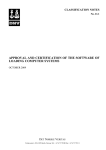

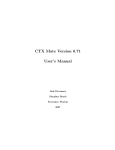

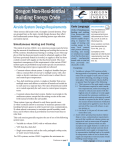
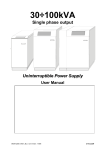
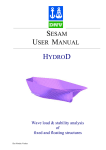
![Corel Office Document [PFP#241512617]](http://vs1.manualzilla.com/store/data/005699212_1-655f6a875c479857ca50d39f97eeaf8f-150x150.png)
